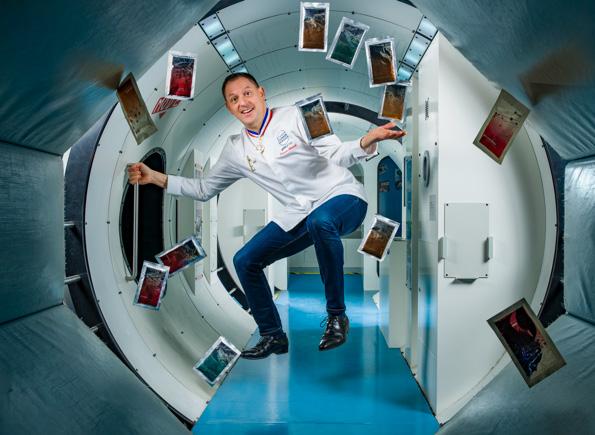
4 minute read
COSMIC CREATIONS Three meals chosen by French aerospace engineer Thomas Pesquet were developed in the kitchens of gategroup’s Servair, giving him a taste of home for the next six months at the International Space Station
The three meal creations from Servair and Chef François Adamski are now circling the earth in the International Space Station
Cosmic creations
Three meals chosen by French aerospace engineer Thomas Pesquet were developed in the kitchens of gategroup’s Servair, giving him a taste of home for the next six months at the International Space Station
by RICK LUNDSTROM
François Adamski (L) and Thomas Pesquet met at Servair One to develop meals for his time at the International Space Station A s you’re reading this story, somewhere up above you, the crew of the International Space Station may be settling in for a meal and savoring dishes with a flavor and complexity that the early astronauts of Gemini and Apollo missions could only imagine.
Circling the Earth at an astounding pace of about five miles per second is space mission Alpha, which launched April 22 aboard a SpaceX rocket. Aboard the mission is French aerospace engineer Thomas Pesquet, who may at this very moment be enjoying a bite of Beef bourguignon. Or, perhaps sharing flambéed crepes with Grand Marnier and orange zest, Suzette style, with fellow spacefarers and talking about how he enjoyed the food as a child.
To pull off such a culinary coup, Pesquet, a former pilot for Air France, did not have to look far for a well-known source. Paris based Servair supplied him with 60 packaged meals (20 from each recipe) that he will ration during his six-month stint aboard the International Space Station.
From Servair One (the oldest and largest unit in Paris)

Pesquet worked with Corporate Chef François Adamski. The pair landed on three dishes chosen from a group of nine that could stand up to the rigors of space travel. In addition to the aforementioned crepes meal, the beef Bourguignon is teamed with smoked farm breast, mushrooms and glazed onions. The third dish is a crunchy and creamy small spelt, melting celery and Périgord truffle.
While hygiene certainly presents one challenge, producing a product that can retain a gourmet flavor in a tricky heating environment is quite the other. Since they are stored at room temperature, the team at Servair adjusted recipes to create meals with reduced sodium and alcohol content. Once heated, they deliver a “dense” texture suitable for consumption in a weightless environment.
Adamski says the major challenges were creating a risotto that would be crunchy and creating meals that would preserve flavor whether they were fresh or in sterilized bags.
The dishes were put to the test weeks before the mission by preparing them in flexible bags, with the help of Servair Engineer Marjorlaine le Guellec. Le Guellec worked with the Technical Center for the Conservation of Agricultural Products to develop sterilization techniques that involves high heat and flexible bags to deliver the finished meals.
The flexible pouches are packed and compacted to cut back on weight and space. During the mission, the plastic bags are filled with water to rehydrate some dried foods, while the Servair meals are heated in a forced-air convection oven.
Admaski called the months of preparation a “beautiful experience.” The Chef, who has been with Servair for two years, says that one of the most comparable experiences is the sous vide cooking process that is often employed for First and Business Class meals on Air France.
“We work diligently to adjust the seasonings every time until we obtained a product that was very close in taste to its non-space version,” he adds.
Adamski says there are limited applications where the skills and techniques used for space travel dining could be employed elsewhere the the caterer’s food service operations. However, they may be useful for military and retail meals that Servair units also supply.
For the astronauts circling day in and day out with the Earth out their window, floating in the blackness of space, the food takes an important role. Astronauts can only count food among approximately 10 percent of their provisions. They are keen to select meals with some important familiarity.
Pesquet, in an interview with the New York Times, said that coming from a nation with such storied cuisine, his fellow astronauts are expecting good food from him to share.
“I’m a terrible cook myself,” he told the Times. “But it’s OK if people are doing it for me.”
Pesquet and Servair’s collaboration is one more chapter in a continuing story that has placed airline caterers at the forefront of food development for space flight. In 2018, German astronaut Alexander Gerst took meals from LSG Sky Chefs on his Horizons mission to the International Space Station. This was before LSG Group’s Europe catering operations were purchased by gategroup. One of Gerst’s bonus meals brought on the trip: a cheese spaetzle with bacon and chicken ragout eventually served on Lufthansa German Airlines on summer long-haul flights.
tray dishwasher
flight type dishwasher

Warewashing systems for up
to 50 000 trays/day
DISKOMAT is your supplier of customized and professional flight catering solutions. Together with our partner WEXIODISK we supply the flight catering industry with Swedish high quality products.
Contact us for more information, info@diskomat.com
trolley washer
cart lifts
www.diskomat.com www.wexiodisk.com









